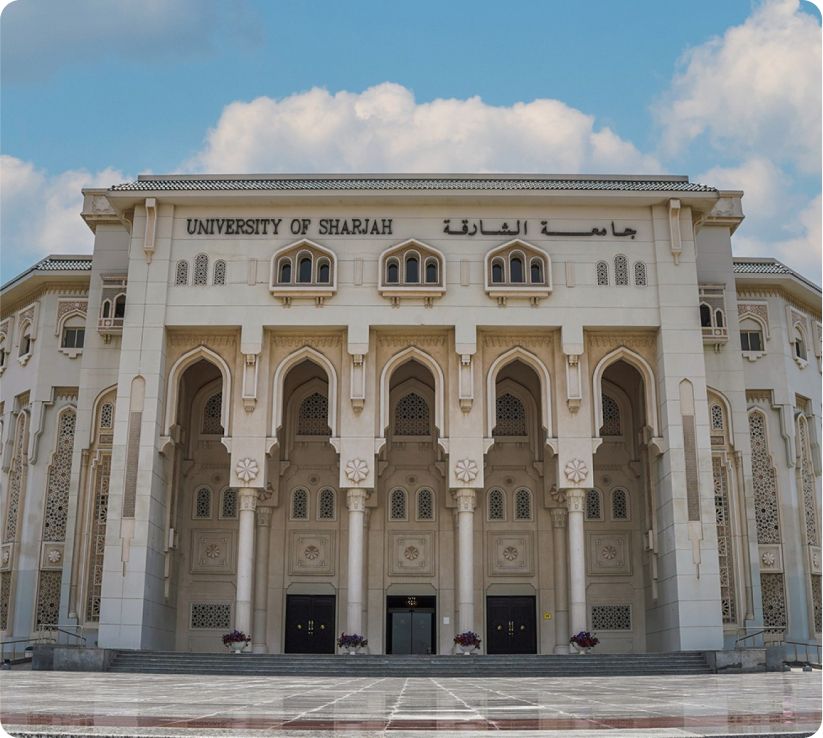Degree Structure
College
Sciences
Department
Applied Physics and Astronomy
Level
Graduate Masters
Study System
Courses and Theses
Total Credit Hours
33 Cr. Hrs.
Duration
2-4 Years
Intake
Fall and Spring
Language
English
Study Mode
Full Time and Part Time
Begin your academic journey with our user-friendly online application platform.
Important Dates
Get access to expert guidance.

Degree Overview
Since its launch in the fall of the 2020-2021 academic year, the Master of Science in Astronomy and Space Sciences program at the University of Sharjah (UoS) has established itself as a key educational initiative in Sharjah. UoS, one of the largest universities in the UAE, boasts over 17,000 students across its various branches in the Emirate. The university offers a wide range of degrees, with astronomy and space sciences as vital components of its academic offerings. To further enhance these disciplines, UoS developed this graduate program alongside its Bachelor of Science degree in Applied Physics and Astronomy.
The Master of Science in Astronomy and Space Sciences aims to deepen and expand the knowledge gained at the undergraduate level, integrating multidisciplinary and interdisciplinary learning with essential research skills and expertise needed for careers in astronomy and space sciences and their applications.
This program is designed to enhance employability by fostering the postgraduate skills required for successful transitions into research roles within academia or research institutions. This is achieved through a combination of master's-level coursework and the completion of research projects. Learning experiences include lectures and hands-on activities at the Sharjah Academy for Astronomy, Space Sciences, and Technology, as well as collaborations with local and international facilities such as the UAE Space Agency and the Mohamed Bin Rashid Space Center. The program's academic objective is to equip students with advanced knowledge and skills in astronomy and space sciences, enabling them to understand the physical universe through astronomical observations from both terrestrial and space-based platforms. Additionally, the program prepares students for independent and collaborative research opportunities across academic, governmental, and industrial sectors.
Program Objectives
The primary goal of the MSc in ASS program is to enhance the academic and professional knowledge of students. It aims to provide essential experience in their chosen areas of focus. Specific objectives of the program include:
• Offering a quality education that fosters an understanding of astronomical and physical concepts as well as space sciences, enabling students to grasp the broader structure of the universe.
• Equipping students with advanced knowledge in astronomy and space sciences technologies, preparing them to address future challenges in the field.
• Providing practical experiences in space sciences research, project development, and management.
• Preparing students for independent and collaborative research in university, government, and industrial settings.
University Requirements
College Requirements
Degree Requirements
Program Structure & Requirements
-
To be awarded the MSc in ASS degree, a student has to complete 33 credit hours distributed as in Table 1.
|
Table 1: Program Components |
|
|
Requirement |
Credit Hours |
|
Compulsory Courses |
12 |
|
Elective Courses |
12 |
|
Thesis |
9 |
|
Total Credit Hours |
33 |
The University of Sharjah has developed and implemented a set of By-Laws that regulate all aspects of graduate studies at the institution. These By-Laws are designed to clarify the rights and responsibilities of faculty, staff, and students, as well as to organize the teaching process. Among the requirements outlined are specific criteria regarding grade point averages and the duration of study.
The requirements for graduation with the M.Sc. in Astronomy and Space Sciences degree are:
-
Passing all courses in the study plan.
-
Completing all the other requirements of the study plan.
-
Accumulating an average GPA of 3.0 or more (on a 4-point scale).
Study Plan
Program Requirements (33 Credit Hours)
The MSc in ASS study plan includes 4 compulsory courses and 4 elective courses in addition to the master thesis. These requirements are summarized in Table 3.
|
Table 3: MSc in ASS study plan |
|||
|
Course Code |
Course Title |
Cr. Hrs. |
Prerequisites |
|
1430501 |
Stellar Astrophysics |
3 |
|
|
1430502 |
Planetary Science |
3 |
|
|
1430503 |
Galactic and Extragalactic Astrophysics |
3 |
|
|
1430504 |
Solar and Space Physics |
3 |
|
|
Elective Course 1 |
3 |
||
|
Elective Course 2 |
3 |
||
|
Elective Course 3 |
3 |
||
|
Elective Course 4 |
3 |
||
|
1430591 |
Thesis Proposal |
3 |
Grad. Standing |
|
1430599 |
Master Thesis |
6 |
Grad. Standing |
Note – Students should complete 12 credit hours of their study plan before they can register for the "Master Thesis" course.
Table 4 lists all of the elective courses offered in the program.
|
Table 4: Electives courses for the MSc in ASS |
||
|
Course Code |
Course Title |
Cr. Hrs. |
|
1430505 |
Observational Astronomical Techniques |
3 |
|
1430506 |
Space Weather |
3 |
|
1430507 |
Celestial Mechanics |
3 |
|
1430508 |
General Relativity |
3 |
|
1430509 |
Data Analysis and Astrostatistics |
3 |
|
1430601 |
Computational Astrophysics |
3 |
|
1430602 |
Radio Astronomy |
3 |
|
1430603 |
Research Methodology |
3 |
|
1430604 |
Atmospheric Physics and Meteorology |
3 |
|
1430605 |
Radiative Processes in Astrophysics |
3 |
|
1430606 |
Variable and Binary Stars |
3 |
|
1430607 |
Cosmology |
3 |
|
1430608 |
Astronomical Optics |
3 |
Course Description
|
1430501 - Stellar Astrophysics (3 crs) |
|
Basic Concepts; Properties of Stars, Classification of Stars and HR Diagram; Binary Stars; Variable Stars; Stellar Formation, Nucleosynthesis, Stellar Evolution, and Stellar Remnants; Stellar Clusters; Radiation Transfer in Stars; Stellar Atmospheres; Stellar Interiors; Chemically Peculiar Stars and Diffusion; The Sun; Research Projects. |
|
1430502 - Planetary Science (3 crs) |
|
This course offers an in-depth exploration of planetary science, focusing on both theoretical and observational perspectives. Students will examine the origin and evolution of the solar system, including the characteristics of its planets and moons, as well as Near-Earth Objects (NEOs), asteroids, and Earth as a model for planetary development. Additional topics include meteorites, impact craters, ice worlds, and recent discoveries in exoplanets. Through lectures and research projects, students will gain a comprehensive understanding of the processes shaping planetary bodies and their implications for habitability and exploration. |
|
1430503 - Galactic and Extragalactic Astrophysics (3 crs) |
|
This course will cover one of the most exciting areas of contemporary astronomy, covering a large variety of phenomena and objects in the Universe. A thorough treatment is given of the physical processes that govern the behavior of particles and emission of radiation in astrophysical environments and then discuss different observable aspects such as neutron stars, black holes, Active Galactic Nuclei, etc. This course will also emphasize on how observations are made and the limitations imposed on them. We will discuss that the new disciplines of radio, millimeter, infrared, ultraviolet, X, and gamma-ray astronomies combined with optical astronomy have led to the growth on many new areas of astrophysics. |
|
1430504 - Solar and Space Physics (3 crs) |
|
This course delves into the physical processes that link the Sun to the planets. It investigates the behavior of the sparse, magnetized plasma that fills the solar system. Key topics include plasma physics, the solar interior and atmosphere, the solar wind, coronal mass ejections, planetary magnetospheres, and space weather. |
|
1430505 - Observational Astronomical Techniques (3 crs) |
|
This course offers an in-depth examination of the tools and techniques that astronomers utilize to observe the universe, blending foundational methods with cutting-edge advancements in multi-messenger astronomy. The curriculum is thoughtfully designed to equip students with essential skills for a variety of observational tasks, including preparation for observation campaigns, photometry, spectroscopy, and spectrophotometry, as well as the handling of telescopes and their mounts. Furthermore, students will receive training in analyzing observational data from various space telescopes. |
|
1430506 - Space Weather (3 crs) |
|
Space weather is an emerging field of space science focused on understanding the societal and technological impacts of the solar-terrestrial relationship. The Sun, which has a tremendous influence on Earth's space environment, releases vast amounts of energy in the form of electromagnetic and particle radiation that can damage or destroy satellite, navigation, communication, and power distribution systems. This is a course about how to forecast space weather. It will give the tools and necessary knowledge to analyze and predict space weather. |
|
1430507 - Celestial Mechanics ( 3 crs) |
|
This course in celestial mechanics treats Newtonian mechanics and gravitation – separate chapters are devoted to Newton's Laws of motion and law of gravitation as applied to system of particles; motion in the gravitation field with an especially full discussion of the two body problem; Keplerian orbits. The course will also treat rigid body rotation, the three-body problem, and also the orbital perturbation theory. |
|
1430508 - General Relativity (3 crs) |
|
Review of special relativity and Newtonian gravity; Gravity as the geometry of curved spacetime; Geodesics and conservation laws; Schwarzschild geometry; Post-Newtonian expansions and tests of general relativity; Gravitational collapse and black holes; Linearized gravity and gravitational waves; Cosmological models for the expanding Universe. |
|
1430509 - Data Analysis and Astrostatistics (3 crs) |
|
This course will cover a variety of topics in the area of Statistics and Probabilities with the intention to utilize them in spectral fitting and parameter determination. The students will get a hands-on experience with conduction and analysis of optical photometry using the telescopes available at our institute. Experience with Bias, Dark frames, flat frames, and Johnson UBVRI system to calibrate their fluxes will be gained. In addition, some basic properties of spectral analysis will be discussed. |
|
1430590 – Project Course (3 crs) |
|
Students who do not opt to take the thesis option must complete the project course. During this phase, students are expected to implement a proposed project as outlined by their project supervisor. Each student is required to prepare a detailed report, a poster, and make a formal presentation of their work that will be used to evaluate their project and verbal and communication skills. |
|
1430599 – Master Thesis (9 crs) |
|
The student has to undertake and complete a research topic under the supervision of a faculty member. The thesis work should provide the student with in-depth perspective of a particular research problem in his chosen field of specialization. It is anticipated that the student be able to carry out his research fairly independently under the direction of his supervisor. The student is required to submit a final thesis documenting his research and defend his work in front of a committee. |
|
1430601 -ComputationalAstrophysics (3 crs) |
|
In this course, the student will encounter for the very first time the environment of modern Theoretical Astrophysics. Although a large part of this course will revise the basic equations governing the relevant topics, the course will mainly focus on the numerical principles and code development to tackle the problem. From Ordinary Differential Equation to sophisticated solvers for Hydrodynamical equations will be discussed. At the end of each topical unit we will solve an important problem using computer language (from low level C to high level such as Python). Also, some visualization tools will be employed. Main topics in this course are: Gravitational Dynamics, Stellar Structure and Evolutions, Hydrodynamics, and Radiative Transfer. |
|
1430602 - Radio Astronomy (3 crs) |
|
This course is to give students the background needed to understand radio astronomy, to recognize when radio observations might help solve an astrophysical problem, and to design, propose, and analyze radio observations. It will cover topics such as descriptions of the properties and use of radio telescopes and various types of receivers needed to analyze cosmic radio signals, the techniques of radiometry, spectroscopy, interferometry, and the descriptions of radiation mechanisms responsible for broadband and spectral line radiation. |
|
1430603 - Research Methodology (3 crs) |
|
This course provides a comprehensive overview of the scientific research process, including literature sources, information gathering, and the writing of scientific articles, theses, and reports. Students will be introduced to the fundamentals of scientific writing and editing, with a strong emphasis on constructing and supporting scientific arguments. The students will learn to utilize a range of tools to access journals, such as NASA ADS, SIMBAD, Google Scholar, and the Web of Knowledge. A significant portion of the course will focus on structuring papers and reports using Microsoft Word and LaTeX, adhering to the templates of leading journals in Astronomy and Astrophysics, including the "Monthly Notices of the Royal Astronomical Society (MNRAS)" and "Astronomy and Astrophysics (A&A)," among others. Students will also explore various writing styles, including theses, reviews, journal articles, and lab reports. Furthermore, the course will incorporate the use of citation management tools such as ZOTERO, Mendeley (for Microsoft Word), and BibTeX (for LaTeX), alongside different citation styles required by journals. Lastly, the course will emphasize the development of essential soft skills, including effective communication and presentation techniques |
|
1430604 - Atmospheric Physics and Meteorology (3 crs) |
|
The course is mainly intended for students to get a grasp on atmospheric physics and meteorology of the Earth. The course introduces the basic terminology, followed by a detailed description of the atmospheric elements (pressure, temperature, humidity, etc.) and ways of measuring them. Moreover, the thermodynamics of the atmosphere including vertical charts, recent models of Earth's atmospheres, and weather forecasting, are discussed. Instabilities in the atmosphere, radiative transfer, and basic hydrodynamics and chemistry, the ozone layer, etc. are included in the course. Also, in the light of the Emirate Mars mission, the last part of the course is dedicated to extraterrestrial atmospheres like the Martian Atmosphere and the capabilities of the mission. |
|
1430605 - Radiative Processes in Astrophysics (3 crs) |
|
The course will discuss classical radiation properties and radiative transfer. More specifically, essential radiative transfer concepts, reddening, Einstein relations, moments of the radiative transfer equation, grey atmosphere, opacities, the Eddington approximation, radiative force, line profile formation, line broadening, the curve of growth, etc. Emission mechanisms such as Bremsstrahlung and synchrotron/cyclotron, as well as Compton scattering will also be discussed. Application to specific objects such as X-ray sources and stellar atmospheres will be discussed. |
|
1430606 - Variable and Binary Stars (3 crs) |
|
The course describes binary stars in terms of the means of their detection: visual, eclipsing, spectroscopic, and astrometric. It will explain the importance of binary stars in determining stellar masses and classify variable stars as either intrinsic or extrinsic and periodic or non-periodic. It will also show the importance of the period-luminosity relationship for determining the distance of cepheids. The course will allow the students to see how to perform an investigation to model the light curves of eclipsing binaries using computer simulation. |
|
1430607 – Cosmology (3 crs) |
|
This course is to give students the necessary cosmological tools to understand the main cosmological principles and the significant recent developments in the field. The course will cover topics such as the cosmological constant, the accelerating Universe, the cosmic microwave background radiation, the different cosmological models, the large-scale structure of the Universe, etc. It will also involve discussions of current theories and recent observations. |
|
1430608 - Astronomical Optics (3 crs) |
|
|
Career Path

How will you make an impact?
Every student’s journey at UoS and beyond is different, which is why our Career & Professional Development team provides personalized career resources to help students make an impact for years to come.




